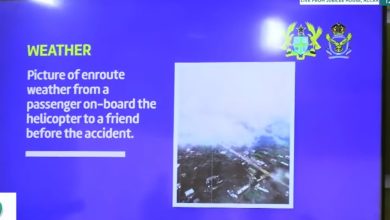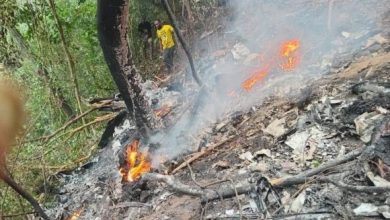Full Report: How the August 6 Helicopter Crash Happened

The investigative committee has provided a detailed account of how the August 6, 2025, military helicopter crash occurred in Ghana, shedding light on the weather conditions, aircraft status, and sequence of events leading to the tragedy.
According to the committee’s findings, the Harbin Z-9EH helicopter, with tail number GHF 631 and callsign IHRI, was assigned to carry out a Ministry of Defence task. The flight was scheduled to depart Accra at 8:00 a.m. and arrive in Obuasi within 50 minutes.
However, the captain delayed take-off due to poor weather conditions in Accra, Kumasi, and Obuasi. The aircraft eventually took off at 9:12 a.m. under marginal weather conditions.
Throughout the flight, the crew adjusted altitude several times to avoid low clouds. Weather reports indicated mist and low visibility across southern Ghana. In Accra, visibility ranged between 5 and 7 kilometres, with clouds as low as 700 feet. Conditions were worse in Kumasi, where drizzle reduced visibility to about 4 kilometres, and thick clouds sat between 600 and 900 feet.
There was limited weather information available along the flight route, and witnesses in the Brofoyedru area reported fog and rain around the time of the crash. Investigators noted that rapid changes in environmental conditions over the terrain could have caused turbulence and downdrafts.
The aircraft was declared serviceable before departure and confirmed to be in good working condition by flight data records.
However, the report noted that the helicopter lacked key safety systems, including a Terrain Awareness and Warning System (TAWS), advanced terrain-mapping navigation, and an Automatic Flight Control System (AFCS). The absence of these systems, the committee stated, may have reduced situational awareness during the flight.
The flight departed Accra under Visual Flight Rules (VFR) but encountered marginal weather en route. For most of the journey—about 90 nautical miles of the 100-mile trip—conditions remained manageable. At 9:56 a.m., the crew entered instrument meteorological conditions (IMC) and transitioned to instrument flying.
Moments before impact, the crew reported sighting high ground below. Seconds later, the helicopter lost height without any change in engine power or pitch attitude. It struck a ridgeline at an altitude of 1,370 feet above sea level, approximately 6.5 miles from its destination, at around 9:58 a.m.
All eight people on board, including senior government officials and military personnel, died in the crash.
The committee has since recommended urgent upgrades to the Ghana Air Force’s fleet, including acquiring aircraft equipped with modern safety and navigation systems to enhance flight safety and prevent future tragedies.
Click Here to read the full Report









